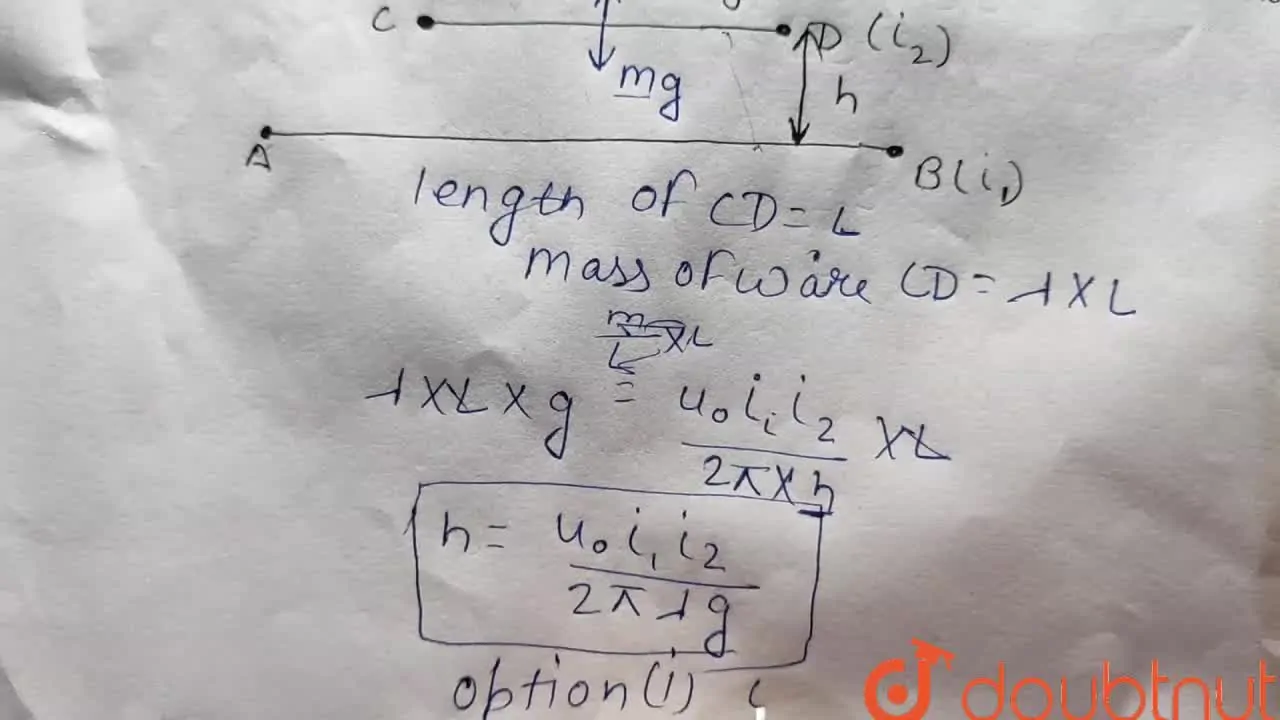The force per unit length between two parallel current carrying wires =μ0i1i22πr . The force is attractive when the current is in same direction and repulsive, when the they are in opposite directions. The force between the wires of two parallel wires is shown. We can determine the equilibrium position. Then we displace upper wire by a small distance, keeping lower wire fixed. If the wire returns to or tries to return to its equilibrium position, its equilibrium is stable. We can thus show that upper wire can execute linear simple harmonic motion or not. The length of wire AB is large as compared to separation between the wires.

If λ is mass per unit length of wire CD, then the equilibrium separation h is given by
h=μ0i1i22πλg
h=2μ0i1i22πλg
h=2πλgμ0i1i2
h=4πλgμ0i1i2
The correct Answer is:A
Step by step video & image solution for The force per unit length between two parallel current carrying wires = (mu_(0)i_(1)i_(2))/(2pir) . The force is attractive when the current is in same direction and repulsive, when the they are in opposite directions. The force between the wires of two parallel wires is shown. We can determine the equilibrium position. Then we displace upper wire by a small distance, keeping lower wire fixed. If the wire returns to or tries to return to its equilibrium position, its equilibrium is stable. We can thus show that upper wire can execute linear simple harmonic motion or not. The length of wire AB is large as compared to separation between the wires. If lamda is mass per unit length of wire CD, then the equilibrium separation h is given by by Physics experts to help you in doubts & scoring excellent marks in Class 12 exams.
Related Playlists
- BOOK - AAKASH INSTITUTECHAPTER - MOVING CHARGES AND MAGNETISMEXERCISE - Assignment Section E (Assertion - Reason Type Questions)8videos
MOVING CHARGES AND MAGNETISM
- BOOK - AAKASH INSTITUTECHAPTER - MOVING CHARGES AND MAGNETISMEXERCISE - Assignment Section F (Matrix-Match Type Questions4videos
MOVING CHARGES AND MAGNETISM
- BOOK - AAKASH INSTITUTECHAPTER - MOVING CHARGES AND MAGNETISMEXERCISE - Assignment Section C (Objective Type Questions (More than one option are correct)14videos
MOVING CHARGES AND MAGNETISM
- BOOK - AAKASH INSTITUTECHAPTER - MOVING CHARGE AND MAGNESIUMEXERCISE - SECTION D16videos
MOVING CHARGE AND MAGNESIUM
- BOOK - AAKASH INSTITUTECHAPTER - NUCLEIEXERCISE - ASSIGNMENT (SECTION-D)10videos
NUCLEI
Similar Questions
The force per unit length between two parallel current carrying wires =μ0i1i22πr . The force is attractive when the current is in same direction and repulsive, when the they are in opposite directions. The force between the wires of two parallel wires is shown. We can determine the equilibrium position. Then we displace upper wire by a small distance, keeping lower wire fixed. If the wire returns to or tries to return to its equilibrium position, its equilibrium is stable. We can thus show that upper wire can execute linear simple harmonic motion or not. The length of wire AB is large as compared to separation between the wires.

If wire CD is in equilibrium position then which of the following may represent the directions of current in the wiresView SolutionForce Between Parallel Current Carrying Wire
View SolutionThe force between two parallel current carrying wires is independent of
View SolutionThe force between two parallel current carrying wires is independent of
View SolutionThere will be no force between two current carrying wires if currents are
View SolutionWhen two wires have current in same direction then force is
View SolutionTwo free parallel wires carrying currents in opposite directions
View SolutionTwo free parallel wires carrying currents in opposite directions
View SolutionTwo free parallel wires carrying currents in opposite directions
View SolutionTwo free parallel wires carrying currents in opposite directions
View Solution


